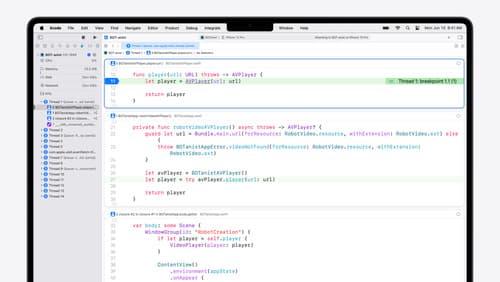task async await
Asked on 2025-04-29
1 search
The concept of async and await in Swift is a key part of its concurrency model, allowing developers to write asynchronous code that is easier to read and maintain. Here's a brief overview based on the content from WWDC:
-
Async/Await Syntax: In Swift, a function that may suspend is marked with the
asynckeyword. When calling an async function, theawaitkeyword is used to indicate that a suspension can occur at that line. This allows the CPU to yield to other tasks while waiting for an asynchronous operation to complete. This is covered in the session A Swift Tour: Explore Swift’s features and design. -
Concurrency and Actors: Swift introduces actors, which are reference types that encapsulate shared mutable state and automatically protect their state by serializing accesses. Calls to actor methods from outside the context of the actor are asynchronous, requiring the use of
await. This is also discussed in the session A Swift Tour: Explore Swift’s features and design. -
Performance Considerations: Async functions in Swift are split into partial functions at runtime, which span the gaps between potential suspension points. This allows for efficient memory allocation and deallocation, as discussed in the session Explore Swift performance.
These sessions provide a comprehensive look at how Swift handles asynchronous operations and concurrency, making it easier to write safe and efficient concurrent code.

A Swift Tour: Explore Swift’s features and design
Learn the essential features and design philosophy of the Swift programming language. We’ll explore how to model data, handle errors, use protocols, write concurrent code, and more while building up a Swift package that has a library, an HTTP server, and a command line client. Whether you’re just beginning your Swift journey or have been with us from the start, this talk will help you get the most out of the language.

Go further with Swift Testing
Learn how to write a sweet set of (test) suites using Swift Testing’s baked-in features. Discover how to take the building blocks further and use them to help expand tests to cover more scenarios, organize your tests across different suites, and optimize your tests to run in parallel.

What’s new in Xcode 16
Discover the latest productivity and performance improvements in Xcode 16. Learn about enhancements to code completion, diagnostics, and Xcode Previews. Find out more about updates in builds and explore improvements in debugging and Instruments.
